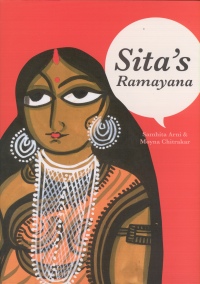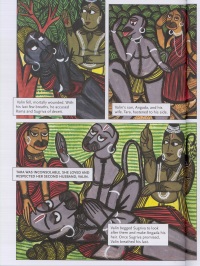| ________________
CM . . . . Volume XVII Number 41 . . . . June 24, 2011
excerpt:
Rama and his queen Sita are banished from their kingdom, and later Sita is captured by King Ravanna who takes her to a faraway garden. He wants her as his wife but is refused. Eventually, Rama and his allies rescue Sita but only after a long and bloody war which brings about the destruction of both human lives and the natural environment. Rama doubts the honesty of Sita's statement that Ravanna never touched her, and he forces her into a literal trial by fire to prove her purity. All seems peaceful until palace gossip again causes Rama to doubt his wife and whether or not he is the father of her unborn child. She is banished to the forest. Time passes, and Rama allows her and the twin boys to return to the palace, but despite his request, Sita refuses to become queen because she knows she will very likely be the object of suspicion again at some later date. She prefers to go to the home of the Earth Goddess in the centre of the planet and is never seen again.
Arni's version of The Ramayana is told through the eyes of a woman which gives the tale a feminist slant. Notes explain that she "builds on a female narrative tradition of the legend" (front cover flap). Not only is Sita sad about the suffering she must personally endure, she is clearly upset and also angry that war causes much needless waste and involves innocent women and children as well as the warriors themselves. Sita is a strong female character who is buffeted by fate and the whims of the men around her yet who ultimately rejects it all and is mistress of her own destiny. Sita's Ramayana takes an ancient tale which evokes The Iliad and The Odyssey of our western literary tradition and updates it in the form of a graphic novel. In fact, notes at the end of the book inform readers that the illustrations for the book were painted first by Moyna Chitrakar, a Patua scroll painter, and then Samhita Arni added the story to accompany them. The tradition of Patua scroll painting is fascinating and is well explained in the afterword notes. The graphics are large, painted in rich, bold colours, and show a variety of stylized Indian characters. This graphic novel will have appeal for various readers for various reasons. Younger readers or reluctant readers will enjoy it simply for the vivid characters, epic adventures and brilliant artwork. Older students will enjoy the book on that level, too, but will also understand its links to other examples of this theme in world literature as well as the place of The Ramayana in Hindu religion. Discussions based on the book could also range to current topics, such as feminism and the role of women in society, as well as the far reaching effects of war on all levels of humankind as well as on the natural world around them. Recommended. Ann Ketcheson, a retired teacher librarian and former teacher of high school English and French, lives in Ottawa, ON.
To comment
on this title or this review, send mail to cm@umanitoba.ca.
Copyright © the Manitoba Library Association. Reproduction for personal
use is permitted only if this copyright notice is maintained. Any
other reproduction is prohibited without permission.
NEXT REVIEW |
TABLE OF CONTENTS FOR THIS ISSUE
- June 24, 2011.
AUTHORS |
TITLES |
MEDIA REVIEWS |
PROFILES |
BACK ISSUES |
SEARCH |
CMARCHIVE |
HOME |

 The original Ramayana was written in Sanskrit by the poet Valmiki around 300 BC. The ancient epic deals with the story of a war over a beautiful woman, reminiscent of Paris, Helen and the Trojan War. Like other myths, the story is full of kings and queens, gods and goddesses, devils and demons, many of whom are capable of morphing into completely different beings as circumstances demand. Fortunately, in this version, the large cast of characters and the relationships among them are clearly laid out in a chart at the beginning of the book.
The original Ramayana was written in Sanskrit by the poet Valmiki around 300 BC. The ancient epic deals with the story of a war over a beautiful woman, reminiscent of Paris, Helen and the Trojan War. Like other myths, the story is full of kings and queens, gods and goddesses, devils and demons, many of whom are capable of morphing into completely different beings as circumstances demand. Fortunately, in this version, the large cast of characters and the relationships among them are clearly laid out in a chart at the beginning of the book.